FOR YOU
Pocket friendly shop of all times and ready to give you the best of study
- 149
- 0
- 1
Community
- Followers
- Following
2 Reviews received
150 items

ATI MED SURG EXAM 1
ATI MED SURG EXAM RETAKE Cushing's syndrome. Clients who have this manifestation present with a round, red, full face.Tremors is incorrect. Tremors are not a common finding of Cushing's syndrome.Obese extremities is incorrect. Clients who have Cushing's syndrome have truncal obesity, a protuberant abdomen, with thin extremities, which is due to an alteration in protein metabolism. 3. A nurse is assisting with the care of a client immediately following a lumbar puncture. Which of the fo...
- Exam (elaborations)
- • 46 pages •
ATI MED SURG EXAM RETAKE Cushing's syndrome. Clients who have this manifestation present with a round, red, full face.Tremors is incorrect. Tremors are not a common finding of Cushing's syndrome.Obese extremities is incorrect. Clients who have Cushing's syndrome have truncal obesity, a protuberant abdomen, with thin extremities, which is due to an alteration in protein metabolism. 3. A nurse is assisting with the care of a client immediately following a lumbar puncture. Which of the fo...

Biological Molecules and Biochemical Processes l3 for applied sciences
Water Water is a small, simple molecule consisting of 2 Hydrogen atoms and an oxygen atom (H2O) which are bonded together with a covalent bond, meaning they share their electrons to create a strong electrostatic attraction. The charges of the atoms in water are partial as you can see in the diagram, the delta symbol in front of the + and -. This is because the electrons are not shared evenly because oxygen is more electronegative than hydrogen, therefore oxygen has a greater pull on the e...
- Summary
- • 16 pages •
Water Water is a small, simple molecule consisting of 2 Hydrogen atoms and an oxygen atom (H2O) which are bonded together with a covalent bond, meaning they share their electrons to create a strong electrostatic attraction. The charges of the atoms in water are partial as you can see in the diagram, the delta symbol in front of the + and -. This is because the electrons are not shared evenly because oxygen is more electronegative than hydrogen, therefore oxygen has a greater pull on the e...
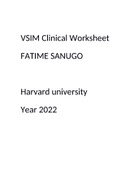
VSIM Clinical Worksheet
Name: Date: November 2, 2022 Initials: FS Age: 23 y.o. M/F: F Code Status: Full Diagnosis: Induction of Labor secondary to postdates Length of stay: 1 day Allergies: No Known HCP: Dr. Schmoe Consults: Lactation Services Isolation: None Fall Risk: HIGH Transfer: Labor and Delivery IV Type: Oxytocin Induction (mU/min) 20 mU/min 500 ml NS IV Location: Mother and Baby Unit Fluid/Rate: Oxytocin Induction (mU/min) 20 mU/min 500 ml NS IV Critical labs: HCT 43...
- Exam (elaborations)
- • 9 pages •
Name: Date: November 2, 2022 Initials: FS Age: 23 y.o. M/F: F Code Status: Full Diagnosis: Induction of Labor secondary to postdates Length of stay: 1 day Allergies: No Known HCP: Dr. Schmoe Consults: Lactation Services Isolation: None Fall Risk: HIGH Transfer: Labor and Delivery IV Type: Oxytocin Induction (mU/min) 20 mU/min 500 ml NS IV Location: Mother and Baby Unit Fluid/Rate: Oxytocin Induction (mU/min) 20 mU/min 500 ml NS IV Critical labs: HCT 43...
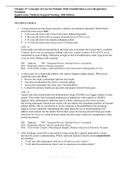
Critical Care of Patients With Acute Coronary Syndromes
1. A client is receiving an infusion of tissue plasminogen activator (tPA). The nurse assesses the client to be disoriented to person, place, and time. What action by the nurse is best? a. Assess the client’s pupillary responses. b. Request a neurologic consultation. c. Call the primary health care provider immediately. d. Take and document a full set of vital signs. ANS: C A change in neurologic status in a client receiving t-PA could indicate intracranial hemorrhage. The nurse would ...
- Exam (elaborations)
- • 14 pages •
1. A client is receiving an infusion of tissue plasminogen activator (tPA). The nurse assesses the client to be disoriented to person, place, and time. What action by the nurse is best? a. Assess the client’s pupillary responses. b. Request a neurologic consultation. c. Call the primary health care provider immediately. d. Take and document a full set of vital signs. ANS: C A change in neurologic status in a client receiving t-PA could indicate intracranial hemorrhage. The nurse would ...
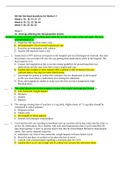
NR 566 Test Bank Questions And Answers for Weeks 5-7 (Chamberlain University)
Kenneth is taking warfarin and is asking about what he can take for minor aches and pains. The best recommendation is: A. Ibuprofen 400 mg three times a day B. Acetaminophen, not to exceed 4 grams per day C. Prescribe acetaminophen with codeine D. Aspirin 640 mg three times a day ____ 2. Juanita had a DVT and was on heparin in the hospital and was discharged on warfarin. She asks her primary care provider NP why she was getting both medications while in the hospital. The best response is...
- Exam (elaborations)
- • 25 pages •
Kenneth is taking warfarin and is asking about what he can take for minor aches and pains. The best recommendation is: A. Ibuprofen 400 mg three times a day B. Acetaminophen, not to exceed 4 grams per day C. Prescribe acetaminophen with codeine D. Aspirin 640 mg three times a day ____ 2. Juanita had a DVT and was on heparin in the hospital and was discharged on warfarin. She asks her primary care provider NP why she was getting both medications while in the hospital. The best response is...
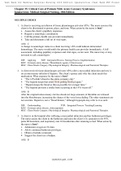
Chapter 27 Concepts of Care for Patients With Noninfectious Lower Respiratory Problems
1. A nurse assesses several clients who have a history of respiratory disorders. Which client would the nurse assess first? a. A 66-year-old client with a barrel chest and clubbed fingernails b. A 48-year-old client with an oxygen saturation level of 92% at rest c. A 35-year-old client who reports orthopnea in bed d. A 27-year-old client with a heart rate of 120 beats/min ANS: D Tachycardia can indicate hypoxemia as the body tries to circulate the oxygen that is available. A barrel chest...
- Exam (elaborations)
- • 12 pages •
1. A nurse assesses several clients who have a history of respiratory disorders. Which client would the nurse assess first? a. A 66-year-old client with a barrel chest and clubbed fingernails b. A 48-year-old client with an oxygen saturation level of 92% at rest c. A 35-year-old client who reports orthopnea in bed d. A 27-year-old client with a heart rate of 120 beats/min ANS: D Tachycardia can indicate hypoxemia as the body tries to circulate the oxygen that is available. A barrel chest...
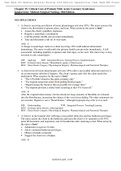
Chapter 35 Critical Care of Patients With Acute Coronary Syndromes.pdf
MULTIPLE CHOICE 1. A client is receiving an infusion of tissue plasminogen activator (tPA). The nurse assesses the client to be disoriented to person, place, and time. What action by the nurse is best? a. Assess the client’s pupillary responses. b. Request a neurologic consultation. c. Call the primary health care provider immediately. d. Take and document a full set of vital signs. ANS: C A change in neurologic status in a client receiving t-PA could indicate intracranial hemorrhage....
- Exam (elaborations)
- • 12 pages •
MULTIPLE CHOICE 1. A client is receiving an infusion of tissue plasminogen activator (tPA). The nurse assesses the client to be disoriented to person, place, and time. What action by the nurse is best? a. Assess the client’s pupillary responses. b. Request a neurologic consultation. c. Call the primary health care provider immediately. d. Take and document a full set of vital signs. ANS: C A change in neurologic status in a client receiving t-PA could indicate intracranial hemorrhage....

NURSING TODAY TRANSITION AND TRENDS 9TH EDITION ZERWEKH TEST BANK
Effective Leadership And Management In Nursing 9th Edition By Sullivan – Test Bank To purchase this Complete Test Bank with Answers Click the link Below If face any problem or Further information contact us At Description Instant Download Effective Leadership And Management in Nursing 9th Edition by Sullivan – Test Bank Sample Questions Effective Leadership & Management in Nursing, 9e (Sullivan) Chapter 3 Delivering Nursing Care 1) The nurse manager tells a newly hired nurse th...
- Summary
- • 42 pages •
Effective Leadership And Management In Nursing 9th Edition By Sullivan – Test Bank To purchase this Complete Test Bank with Answers Click the link Below If face any problem or Further information contact us At Description Instant Download Effective Leadership And Management in Nursing 9th Edition by Sullivan – Test Bank Sample Questions Effective Leadership & Management in Nursing, 9e (Sullivan) Chapter 3 Delivering Nursing Care 1) The nurse manager tells a newly hired nurse th...
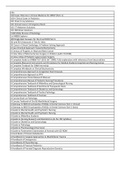
Clinical medicine Test Bank (contains 1000+ questions on clinical medicine)
100 Cases Histories in Clinical Medicine for MRCP (Part-1) 100+ Clinical Cases in Pediatrics 101 Chest X-ray Solutions 101 Clinical Cases in Emergency Room 101 CT Abdomen Solutions 101 MRI Brain Solutions 1500 MCQs Review of Radiology 1st MBBS Explorer 300 Single Best Answers for the Final FRCR Part A 3D and 4D Ultrasound: A Text & Atlas 50 Cases in Clinical Cardiology: A Problem Solving Approach A Case Oriented Approach Towards Biochemistry A Century of Progress in Head and Neck Can...
- Summary
- • 395 pages •
100 Cases Histories in Clinical Medicine for MRCP (Part-1) 100+ Clinical Cases in Pediatrics 101 Chest X-ray Solutions 101 Clinical Cases in Emergency Room 101 CT Abdomen Solutions 101 MRI Brain Solutions 1500 MCQs Review of Radiology 1st MBBS Explorer 300 Single Best Answers for the Final FRCR Part A 3D and 4D Ultrasound: A Text & Atlas 50 Cases in Clinical Cardiology: A Problem Solving Approach A Case Oriented Approach Towards Biochemistry A Century of Progress in Head and Neck Can...

ATI Pharmacology Proctored exam 2019-complete
1. The nurse is caring for a patient in preadmission testing. The patient has been assigned a physical status classification by the American Society of Anesthesiologists of ASA III. Which assessment will support this classification? a. Normal, healthy patient b. Denial of any major illnesses or conditions c. Poorly controlled hypertension with implanted pacemaker d. Moribund patient not expected to survive without the operation ANS: C An ASA III rating is a patient with a severe systemi...
- Exam (elaborations)
- • 21 pages •
1. The nurse is caring for a patient in preadmission testing. The patient has been assigned a physical status classification by the American Society of Anesthesiologists of ASA III. Which assessment will support this classification? a. Normal, healthy patient b. Denial of any major illnesses or conditions c. Poorly controlled hypertension with implanted pacemaker d. Moribund patient not expected to survive without the operation ANS: C An ASA III rating is a patient with a severe systemi...

Varcarolis’ Foundations of Psychiatric Mental Health Nursing A Clinical Approach, 8th Edition TEST BANK LA
ATI Pharmacology Study Guide with Answers